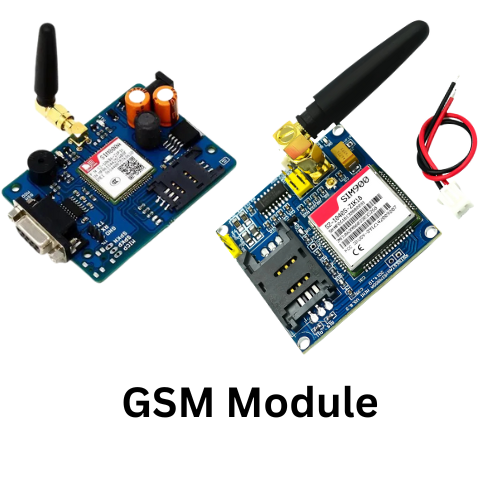A GSM Module (Global System for Mobile Communications) is a hardware device that allows microcontrollers, computers, or other embedded systems to communicate over a mobile network. It provides a communication interface that can send and receive SMS (Short Message Service) messages, make and receive calls, and even connect to the internet via mobile data, depending on the module’s capabilities.
Key Features of a GSM Module:
-
SMS Functionality: A GSM module can send and receive text messages (SMS). It is commonly used in applications like remote monitoring, alarms, and notification systems.
-
Voice Calling: GSM modules support making and receiving voice calls. You can integrate this feature into systems that require phone call-based communication, such as automated dialing systems.
-
Data Communication: Many GSM modules support GPRS (General Packet Radio Service) or EDGE (Enhanced Data rates for GSM Evolution), allowing internet connectivity for applications like remote control, IoT systems, or GPS-based services.
-
Low Power Consumption: Most GSM modules are designed to be power-efficient, making them ideal for battery-operated systems.
-
AT Commands: The GSM module is controlled using AT (Attention) commands. These are simple text commands sent to the module to perform operations like sending SMS, making calls, checking signal strength, etc.
-
Multiple Frequency Bands: GSM modules typically operate in multiple frequency bands (900 MHz, 1800 MHz, etc.), ensuring compatibility with networks around the world.
Popular GSM Modules:
-
SIM900: One of the most commonly used modules, providing SMS, voice, and data communication functionality. It’s widely supported and easy to integrate with microcontrollers.
-
SIM800: A more compact module similar to the SIM900, supporting a wide range of features including SMS, voice calls, and GPRS internet functionality.
-
SIM5320: An advanced GSM module that supports 3G networks in addition to basic GSM functionality, providing faster data speeds.
-
SIM868: A combination of GSM, GPS, and Bluetooth in one module, useful for applications that need both mobile communication and location tracking.
Applications of GSM Modules:
-
Remote Monitoring Systems: For sending alerts or status updates via SMS, such as in home automation or security systems.
-
IoT Projects: Enabling internet connectivity for IoT devices in remote locations.
-
Automated Systems: Systems like smart meters, vehicle tracking, or alarm systems that need to send notifications via SMS or make automated calls.
-
Location-Based Services: Using GSM modules combined with GPS for real-time location tracking.
How It Works:
-
Power Supply: The module is powered via an external supply (typically 3.3V to 5V).
-
SIM Card: A SIM card (Subscriber Identity Module) is inserted into the GSM module, just like a mobile phone, to access the cellular network.
-
Communication: The module communicates with the host system (like an Arduino or Raspberry Pi) using serial communication (UART, TX/RX pins). AT commands are sent to control the GSM module.
-
Sending SMS: To send an SMS, an AT command like
AT+CMGS="phone_number"is used, followed by the message content. The module then sends the message to the specified number over the mobile network.


Reviews
Clear filtersThere are no reviews yet.